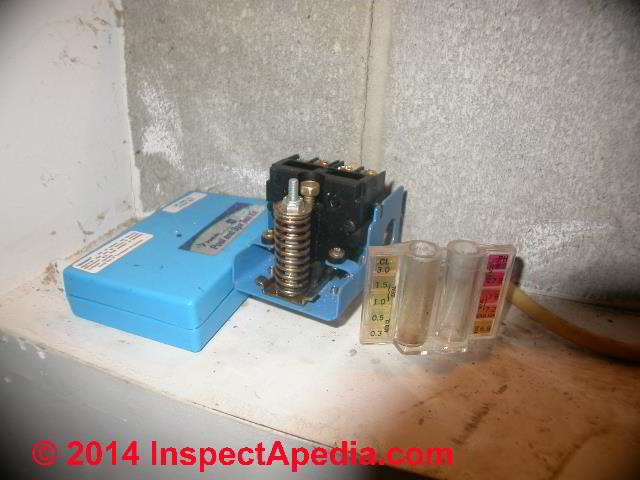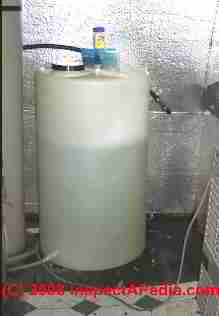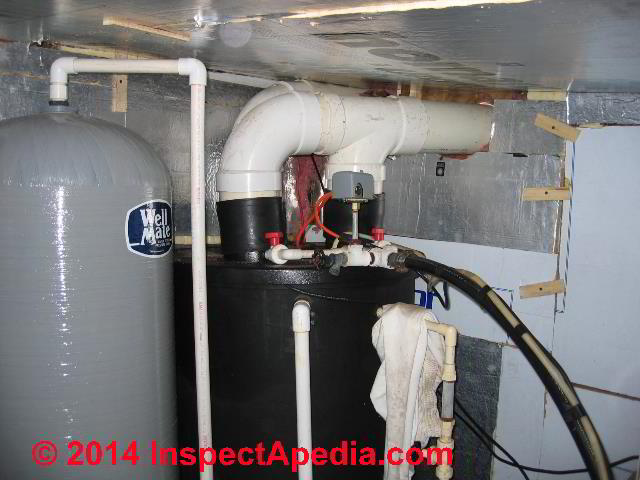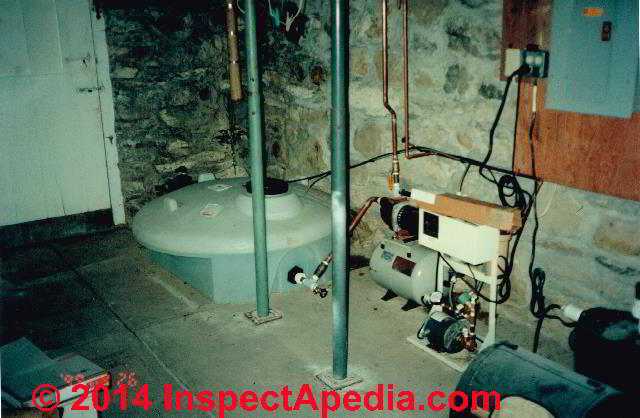 Water Chlorinators & Charcoal Filters
Water Chlorinators & Charcoal Filters
Use of Chlorine Treatment Systems for Contaminated Drinking Water
- POST a QUESTION or COMMENT about choosing, installing, maintaining & repairing chlorinators, water purifiers and water treatment systems
Water chlorination systems for buildings: here we explain how to install, use, & repair or maintain drinking water chlorinators or chlorine injection systems for correcting unsanitary or unsatisfactory drinking water.
InspectAPedia tolerates no conflicts of interest. We have no relationship with advertisers, products, or services discussed at this website.
- Daniel Friedman, Publisher/Editor/Author - See WHO ARE WE?
Chlorinators with Charcoal Filters for Water Purification
A typical very effective treatment system for water contaminated by a persistent source bacterial contamination involves the injection of chlorine into the water supply, a holding tank to permit sufficient exposure time and concentration for the chlorine to do its work, and a post-processing charcoal filter to remove the chlorine from the water as it leaves the system.
Photo above: a closer look at the chlorine (mixed with water) tank used to inject chlorine into the drinking water supply.
Besides bacteria what else will a chlorinator remove from drinking water?
Chlorine treatment water purification systems will also remove modest levels of sulphur, sulphur generating bacteria, and other odors.
If the water has a high level of sediment, pre-filtering may be necessary to avoid clogging the charcoal with debris. There is an operating cost as the charcoal filters need to be changed periodically.
Also see WATER TREATMENT EQUIPMENT DISINFECTION - separate article describing the requirement to disinfect water softeners, filters, and other water handling equipment.
Above our photograph shows the mixing and holding tank into which chlorine (or bleach solution) is injected for well water disinfection. The water holding tank is intended to provide sufficient contact time for the chlorine injected into the water so that it can adequately kill microorganisms.
Keep in mind that chlorine or other disinfection methods alone simply are intended to kill living pathogens.
They do not remove odors, minerals or other un-wanted ingredients that may be found in some water supplies.
Below our the photograph shows a typical chlorine injection pump used on an automatic chlorine injection system for water disinfection.
Chlorine injection pumps may be activated by water usage or by a clock or timer and must be able to withstand the corrosivity of the disinfectant.
OPINION: A water treatment specialist will often test your water at no charge in order to develop a profile of the contaminants or aesthetic contaminants in water and thus to recommend a specific water treatment system.
This "free water test" service is a great deal for building owners and buyers so long as they realize that the water treatment company wants to sell water treatment equipment.
The building owner where this water chlorination system was installed preferred to make his own frequent tests of the chlorine level in the building water supplyh. He was using a swimming pool test kit to check for residual chlorine levels in the water holding tank (photo at below left).
See CHLORAMINE TESTS, WATER for some better suggestions.
 Some of our readers indicate that they were mistrustful of calling a company that sells water treatment equipment to ask for advice.
Some of our readers indicate that they were mistrustful of calling a company that sells water treatment equipment to ask for advice.
Although we have encountered a few aggressive sales people, we have never found a water treatment company professional who gave dishonest advice about what was found in drinking water and what water treatment options can be provided.
Only a very foolish water salesman would be dishonest about what's in the water, but some companies may be reluctant to outline all of the treatment alternatives.
f you're in doubt have some independent water tests done before spending on a costly system.
If we had to live with bacteria in our water supply, this would be our treatment system of choice.
More information on chlorine in water and in septic systems:
and also
CHLORINE IN SEPTIC WASTEWATER.
Below is a water disinfection system combining a chlorine injection (the small white tube shown in the lower right of the image) and gas & odor (and possibly radon) removal (the large white vents at the top of the water storage tank).
Below we show a water de-salination and disinfection system installed in the basement of a New York home in the U.S.
This system was actually designed for shipboard use according to the building owner.
Reverse Osmosis (previously discussed in a prior edition of this article) is also used for water that is high in mineral content, suffers from odor problems or other contaminants and has the feature that additional chemicals such as chlorine are not required.
Details about RO systems are now found
at REVERSE OSMOSIS WATER TREATMENT
This series of articles explains many common water contamination tests for bacteria and other contaminants in water samples. We describe what to do about contaminated water, listing common corrective measures when water test results are unsatisfactory.
We include water testing and water correction measures warnings for home owners and especially for home buyers when certain conditions are encountered, with advice about what to do when these circumstances are encountered.
Home Chlorinator + Charcoal Filter Water Treatment Effectiveness Research
- Andersson, Anneli, Patrick Laurent, Anne Kihn, Michèle Prévost, and Pierre Servais. "Impact of temperature on nitrification in biological activated carbon (BAC) filters used for drinking water treatment." Water research 35, no. 12 (2001): 2923-2934.
- Ahmedna, Mohamed, Wayne E. Marshall, Abdo A. Husseiny, Ramu M. Rao, and Ipek Goktepe. "The use of nutshell carbons in drinking water filters for removal of trace metals." Water Research 38, no. 4 (2004): 1062-1068.
- Babu, Raveendra, and Malay Chaudhuri. "Home water treatment by direct filtration with natural coagulant." J Water Health 3 (2005): 27-30.
- Betancourt, Walter Q., and Joan B. Rose. "Drinking water treatment processes for removal of< i> Cryptosporidium</i> and< i> Giardia</i>." Veterinary parasitology 126, no. 1 (2004): 219-234.
- Colford, John M., Timothy J. Wade, Sukhminder K. Sandhu, Catherine C. Wright, Sherline Lee, Susan Shaw, Kim Fox et al. "A randomized, controlled trial of in-home drinking water intervention to reduce gastrointestinal illness." American Journal of Epidemiology 161, no. 5 (2005): 472-482.
- Diao, H. F., X. Y. Li, J. D. Gu, H. C. Shi, and Z. M. Xie. "Electron microscopic investigation of the bactericidal action of electrochemical disinfection in comparison with chlorination, ozonation and Fenton reaction." Process biochemistry 39, no. 11 (2004): 1421-1426.
- Gadgil, Ashok. "Drinking water in developing countries." Annual review of energy and the environment 23, no. 1 (1998): 253-286.
- Haman, Dorota Z., and Adelbert Brace Bottcher. Home water quality and safety. Florida Cooperative Extension Service, Institute of Food and Agricultural Sciences, University of Florida, 1986.
- Himberg, K., A-M. Keijola, L. Hiisvirta, H. Pyysalo, and K. Sivonen. "The effect of water treatment processes on the removal of hepatotoxins from< i> Microcystis</i> and< i> Oscillatoria</i> cyanobacteria: A laboratory study." Water Research 23, no. 8 (1989): 979-984.
- Jurczak, Tomasz, Malgorzata Tarczynska, Katarzyna Izydorczyk, Joanna Mankiewicz, Maciej Zalewski, and Jussi Meriluoto. "Elimination of microcystins by water treatment processes—examples from Sulejow Reservoir, Poland." Water Research 39, no. 11 (2005): 2394-2406.
- Kim, B. R., J. E. Anderson, S. A. Mueller, W. A. Gaines, and A. M. Kendall. "Literature review—efficacy of various disinfectants against< i> Legionella</i> in water systems." Water Research 36, no. 18 (2002): 4433-4444.
- Le Dantec, Corinne, Jean-Pierre Duguet, Antoine Montiel, Nadine Dumoutier, Sylvie Dubrou, and Véronique Vincent. "Occurrence of mycobacteria in water treatment lines and in water distribution systems." Applied and environmental microbiology 68, no. 11 (2002): 5318-5325.
- Li, Xiao-yan, and Hiu Ping Chu. "Membrane bioreactor for the drinking water treatment of polluted surface water supplies." Water Research 37, no. 19 (2003): 4781-4791.
- Luby, Stephen E., Amber H. Syed, Naureen Atiullah, Mohammad K. Faizan, and Susan Fisher-Hoch. "Limited effectiveness of home drinking water purification efforts in Karachi, Pakistan." International Journal of Infectious Diseases 4, no. 1 (2000): 3-7.
- Matilainen, Anu, Niina Lindqvist, Susanna Korhonen, and Tuula Tuhkanen. "Removal of NOM in the different stages of the water treatment process." Environment International 28, no. 6 (2002): 457-465.
- Reynolds, Kelly A., Kristina D. Mena, and Charles P. Gerba. "Risk of waterborne illness via drinking water in the United States." Reviews of environmental contamination and toxicology. Springer New York, 2008. 117-158.
- Richardson, Susan D., Michael J. Plewa, Elizabeth D. Wagner, Rita Schoeny, and David M. DeMarini. "Occurrence, genotoxicity, and carcinogenicity of regulated and emerging disinfection by-products in drinking water: a review and roadmap for research." Mutation Research/Reviews in Mutation Research 636, no. 1 (2007): 178-242.
- Richardson, S. D., A. D. Thruston Jr, T. V. Caughran, P. H. Chen, T. W. Collette, K. M. Schenck, B. W. Lykins Jr, Ch Rav-Acha, and V. Glezer. "Identification of new drinking water disinfection by-products from ozone, chlorine dioxide, chloramine, and chlorine." In Environmental Challenges, pp. 95-102. Springer Netherlands, 2000.
- Simpson, David R. "Biofilm processes in biologically active carbon water purification." Water research 42, no. 12 (2008): 2839-2848.
- Sobsey, Mark D., Sanitation Water, and World Health Organization. "Managing water in the home: accelerated health gains from improved water supply/prepared by Mark D. Sobsey." (2002).
- WATER QUALITY & QUANTITY San Miguel de Allende
...
Continue reading at CHLORAMINE TESTS, WATER or select a topic from the closely-related articles below, or see the complete ARTICLE INDEX.
Or see
- CHLORINATORS & CHARCOAL FILTERS
- CHLORINE HAZARDS in WATER
- CHLORINE IMPACT on SEPTIC
- CHLORINE SOURCES in WASTEWATER
- CHLORINE TESTS, WATER
- FILTERS for DRINKING WATER PURIFICATION
- REVERSE OSMOSIS WATER TREATMENT
- WATER DISINFECTANT QUANTITY
- WATER TREATMENT EQUIPMENT CHOICES - home
- WATER ODOR TREATMENTS, CURES - SULPHUR
- WELL DISINFECTANT pH ADJUSTMENT
Suggested citation for this web page
CHLORINATORS & CHARCOAL FILTERS at Ins pectApedia.com - online encyclopedia of building & environmental inspection, testing, diagnosis, repair, & problem prevention advice.
Or see this
INDEX to RELATED ARTICLES: ARTICLE INDEX to WATER TREATMENT SYSTEMS
Or use the SEARCH BOX found below to Ask a Question or Search InspectApedia
Ask a Question or Search InspectApedia
Questions & answers or comments about choosing, installing, maintaining & repairing chlorinators or RO (reverse osmosis) water purifiers and water treatment systems
Try the search box just below, or if you prefer, post a question or comment in the Comments box below and we will respond promptly.
Search the InspectApedia website
Note: appearance of your Comment below may be delayed: if your comment contains an image, photograph, web link, or text that looks to the software as if it might be a web link, your posting will appear after it has been approved by a moderator. Apologies for the delay.
Only one image can be added per comment but you can post as many comments, and therefore images, as you like.
You will not receive a notification when a response to your question has been posted.
Please bookmark this page to make it easy for you to check back for our response.
IF above you see "Comment Form is loading comments..." then COMMENT BOX - countable.ca / bawkbox.com IS NOT WORKING.
In any case you are welcome to send an email directly to us at InspectApedia.com at editor@inspectApedia.com
We'll reply to you directly. Please help us help you by noting, in your email, the URL of the InspectApedia page where you wanted to comment.
Citations & References
In addition to any citations in the article above, a full list is available on request.
- Crystal Clear Supply provides portable ceramic water filter purifiers and portable reverse osmosis water treatment equipment - see http://www.crystalclearsupply.com/category_s/7.htm
- Handbook of Disinfectants and Antiseptics, Joseph M. Ascenzi (Editor), CRC, 1995, ISBN-10: 0824795245 ISBN-13: 978-0824795245 "The evaluation of chemical germicides predates the golden age of microbiology..." -
This well-focused, up-to-date reference details the current medical uses of antiseptics and disinfectants -- particularly in the control of hospital-acquired infections -- presenting methods for evaluating products to obtain regulatory approval and examining chemical, physical, and microbiological properties as well as the toxicology of the most widely used commercial chemicals. - Potable Aqua® emergency drinking water germicidal tablets are produced by the Wisconsin Pharmacal Co., Jackson WI 53037. 800-558-6614 pharmacalway.com
- Principles and Practice of Disinfection, Preservation and Sterilization (Hardcover)
by A. D. Russell (Editor), W. B. Hugo (Editor), G. A. J. Ayliffe (Editor), Blackwell Science, 2004. ISBN-10: 1405101997, ISBN-13: 978-1405101998.
"This superb book is the best of its kind available and one that will undoubtedly be useful, if not essential, to workers in a variety of industries. Thirty-one distinguished specialists deal comprehensively with the subject matter indicated by the title ... The book is produced with care, is very readable with useful selected references at the end of each chapter and an excellent index. It is an essential source book for everyone interested in this field. For pharmacy undergraduates, it will complement the excellent text on pharmaceutical microbiology by two of the present editors."
The Pharmaceutical Journal: "This is an excellent book. It deals comprehensively and authoritatively with its subject with contributions from 31 distinguished specialists. There is a great deal to interest all those involved in hospital infection ... This book is exceptionally well laid out. There are well chosen references for each chapter and an excellent index. It is highly recommended." The Journal of Hospital Infection.: "The editors and authors must be congratulated for this excellent treatise on nonantibiotic antimicrobial measures in hospitals and industry ... The publication is highly recommended to hospital and research personnel, especially to clinical microbiologists, infection-control and environmental-safety specialists, pharmacists, and dieticians."
New England Journal of Medicine: City Hospital, Birmingham, UK. Covers the many methods of the elimination or prevention of microbial growth. Provides an historical overview, descriptions of the types of antimicrobial agents, factors affecting efficacy, evaluation methods, and types of resistance. Features sterilization methods, and more. Previous edition: c1999. DNLM: Sterilization--methods. - When Technology Fails, Matthew Stein, Chelsea Green Publisher, 2008,493 pages. ISBN-10: 1933392452 ISBN-13: 978-1933392455, "... how to find and sterilize water in the face of utility failure, as well as practical information for dealing with water-quality issues even when the public tap water is still flowing". Mr. Stein's website is www.whentechfails.com/
- Our recommended books about building & mechanical systems design, inspection, problem diagnosis, and repair, and about indoor environment and IAQ testing, diagnosis, and cleanup are at the InspectAPedia Bookstore. Also see our Book Reviews - InspectAPedia.
- In addition to citations & references found in this article, see the research citations given at the end of the related articles found at our suggested
CONTINUE READING or RECOMMENDED ARTICLES.
- Carson, Dunlop & Associates Ltd., 120 Carlton Street Suite 407, Toronto ON M5A 4K2. Tel: (416) 964-9415 1-800-268-7070 Email: info@carsondunlop.com. Alan Carson is a past president of ASHI, the American Society of Home Inspectors.
Thanks to Alan Carson and Bob Dunlop, for permission for InspectAPedia to use text excerpts from The HOME REFERENCE BOOK - the Encyclopedia of Homes and to use illustrations from The ILLUSTRATED HOME .
Carson Dunlop Associates provides extensive home inspection education and report writing material. In gratitude we provide links to tsome Carson Dunlop Associates products and services.





